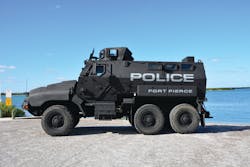On a bitter cold, snowy Monday in December Fond du Lac, Wisconsin SWAT responded to a call of a barricaded subject armed with .50 caliber armor-piercing rounds. The suspect had already begun to fire upon initial responding officers as they arrived.
Earlier in the day the subject was suspected of having lit a family home on fire before fleeing to this second location, a multi-family apartment complex. Members of the SWAT—Crisis Negotiations initiated telephone contact with the suspect while other officers gathered information. They determined the suspect was in possession of a stockpile of ammunition, ballistic shields and vests; more firearms in addition to the .50 rifle. Through the course of a several-hour standoff it became known that four innocent civilians were in the building, too.
Officer Ben Colwin was tasked with developing a plan to extract the four citizens without alerting the suspect. “I recognized that the only way we were going to be able to safety extract the citizens, was if we approached from the west side of the building. This was the only side that the suspect could not see us approach from,” recalled Colwin. On the west side of the yard was a very steep, icy embankment that threatened a smooth rescue.
In a stroke of good timing, perhaps, the agency had just acquired its first armored vehicle thanks to the generosity of the Joe and Dawn Colwin Family Foundation, and the company had thrown in a tire upgrade for good measure. “One of our motivations [in purchasing the vehicle] was to have it as an immediate response vehicle and our team did just that; they had it on scene in short-order.” Says Captain Lamb. With the perimeter secured the next thought was for safely extracting the citizens in the building.
The SWAT team used two other vehicles to help maintain the integrity of the perimeter with ballistic protection. Then they used the new armored vehicle and took it over the embankment, clearing the ground by less than one inch and backing it right up to the building.
Lamb remembers, “The shield team went in and we were able to coordinate and get those other innocent civilians safely out of their apartments into our armed vehicle. We got them out of there.”
From bread truck to beast
Years ago, a police department’s designated ‘SWAT vehicle’ likely would not withstand .50 rounds or traverse steep embankments like it was nothing. These earlier mobile task masters didn’t have much in the way of ballistic protection or shooting platforms. Rather, they were usually glorified vans—16-passenger “raid vans” or “bread trucks” that could fit a good number of people inside.
Chris Amon, special agent with Alcohol, Tobacco and Firearms, is currently assigned to ATF public affairs, but is also a part-time crisis negotiator assigned to the Washington D.C. special response team. “Like most SWAT teams, when situations rise to a higher level, that’s when we call in the SRT,” says Amon—to serve a high-risk warrant or to arrest a suspect with a propensity for exceptional violence. Amon’s team depends on the added protection armed vehicles offer in his role of negotiator.
“My role is to ensure that I can open a line of communication with the suspect. And you can’t do that if you’re worried about bullets whizzing over your head.
“From ATF’s point of view, we go after the worst of the worst criminal,” says Amon. The team’s near 17,000-pound, 16-passenger BearCat provides security at least up until the point when officers get up, get out of the vehicle and head to the door.
The real steel
These vehicles are not a small investment. Lenco armored trucks on display at SHOT Show in January were priced around $225,000. It is a beast of a truck.
“I don’t know what the gas tank holds, but I know it gets 3-4 miles to the gallon,” Lamb recalls his officers had to stop for gas more than a few times when they picked up the vehicle and made their way from Massachusetts to Wisconsin.
Lenco’s BearCat, the same vehicle used by Amon and Fond du Lac PD, is built in Pittsfield in the hills of Western Massachusetts. Lenco cut its teeth manufacturing armored bank trucks, cash and transit trucks, as well as up-armored tactical vehicles for forces around Latin America and Europe. They switched exclusively to the U.S. law enforcement market in the late nineties.
Normal bank trucks have a fairly modest armor rating; traditionally they will withstand 9mm handguns. Today the company’s Bear and BearCat models are known for their armor protection. “A lot of the armor on the bank trucks is the same material we would use on our bench seats today” says Lenny Light, Lenco’s vice president and general manager. Lenco uses Mil-Spec military-grade steel on all of its vehicles. Every piece of steel is shipped to Aberdeen, Maryland and tested to ensure it meets U.S. Army requirements. Both glass and steel is designed to withstand .50 caliber rounds.
In the vest industry, NIJ regulates products and materials closely. There is no similar oversight body in the armored vehicle industry. However, the Department of Defense and state department do regulate the materials, as well as the production process, utilized in the construction of these vehicles used in the military. This is the standard to which Lenco builds. “The same materials, standards, and procedures we use for state department vehicles and our U.S. Navy vehicles and our U.S. Air Force vehicles, we all use those for our U.S. SWAT vehicles as well,” says Light.
Throughout the year they’ll build a handful of demo vehicles, as some customers want ready and available. But for the most part, every truck in production has been “spec-ed out” by an end-user and designed in 3d Solid Works by the engineering team, and then goes through the production process until finally it is inspected and delivered to the end-user.
Pulling double-duty
Heavy duty armored vehicles are making sense to more law enforcement agencies as they respond to an ever-increasing number of active shooter situations and circumstances where suspects are armed-to-the-teeth. Slowly, this one-time niche industry is picking up speed. And some manufacturers are getting creative. The company Ring Power in St. Augustine, Florida makes an Armored Critical Incident Vehicle that’s smaller in size but still heavy duty. The Rook comes with several attachments that can be purchased as a package. Teams are using the vehicle for barricade and crowd control scenarios in particular.
With the Rook officers can pull up onsite and maintain cover. “They can approach a house or go through a mall and they don’t have to expose themselves,” says Shaun Mitchell, assistant vice president and general manager of Tactical Solutions and Ring Power.
The vehicle’s low ground pressure maneuvers it to the backside of houses, down stairs or through narrow hallways. When it’s not being used for SWAT purposes the Rook can move cars (forklift-style) or help with storm cleanup…operators could even hook a snow blower to it to clear roads. The machine itself holds one person, but the company also has rear and front armored deployment platforms that fit five a-piece. The armored platform elevates and is capable of doing second-story entries.
“Say you’ve got a rural area where there’s a house and no cover anywhere. You can take that platform, drop it off and have a team right next to a situation behind Level 4 armor,” says Mitchell.
Rook is on its fourth-generation of design and each vehicle is custom-built. Users recently requested tapered sides on the platform, slide-in side panels, more glass and better visibility. The company has also added a gas-deployment system.
It’s wired for investigating, too. Lowlight, infrared cameras on the vehicle transmit video feed back to command center. There’s one camera inside the machine, two in the front of the platform, and then five on the end of the ram: top, bottom, sides and an infrared in the front.
Pennsylvania State police recently purchased two Rooks. Says Mitchell, “We’re re-designing one of the escape hatches to make for an easier exit; if they had to exit the machine it’s actually an exit and a shooting point. But yes, we’re always innovating, trying to make it better.” He’s noticed a jump in law enforcement customers despite being a fairly new company.
Assess your needs
The rules of tactical response are changing. Light says his business was very niche in the beginning, but with each year that passes armored vehicles become standard operating procedure. “The days of running up to a door with a shield on your arm…are over. You don’t have to do that anymore. You don’t have to put yourself in harm’s way like that. These truck allow these guys to respond to situations in a different tactical way that keeps them safe. They bring these incidents to a resolution peacefully, without getting anyone injured.”
Lamb and Colwin firmly believe the rescue portion of their operation would not have been as successful without the tires. More than that, Lamb believes the vehicle saved lives.
“There’s absolutely no doubt in my mind. I reached out to the foundation…and I said I can’t prove this, but I’m pretty sure you saved lives on December 9.”
Chief Lamb looked as his agencies needs in strategic planning and decided this was one piece of equipment worth its cost. Less than three years ago his agency lost an officer who was feloniously shot and killed. Not far from home, cities Brookfield and Oak Creek saw a fair share of active shooter incidents in a relatively short period of time. For Lamb, it just made sense.
“The simple fact of the matter is, we don’t have the luxury of hoping for the best. We need to prepare for the worst. The simple fact is, you can hardly turn on the news, or log on and read the news, without reading about some type of tragic active shooter situation somewhere in the United States on what seems like a weekly or in some instances, near daily basis.
“Every chief or sheriff needs to decide what’s best for their community. We just determined that based on…some experiences but also perceived threats, it was a resource we had to pursue and we were fortunate enough to get it.”
About the Author

Sara Scullin
Sara Scullin was the Editor of Law Enforcement Technology magazine, a monthly business-to-business publication that covers technology trends and best practices for public safety managers. LET is part of SouthComm Law Enforcement Media, which also publishes Law Enforcement Product News and Officer.com. Sara had covered the law enforcement industry since March 2008.
